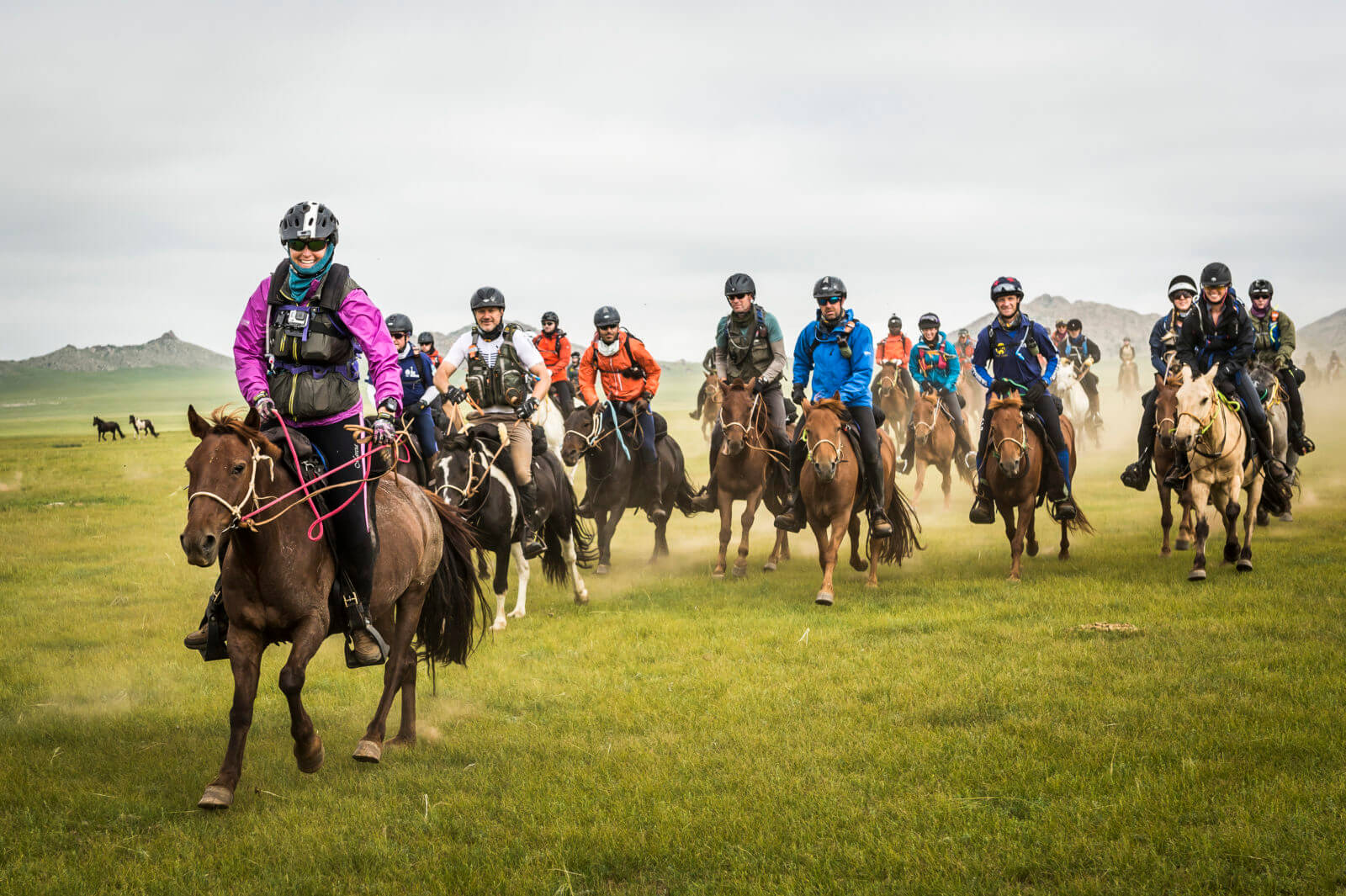Mongol Derby: The Ultimate Equestrian Challenge

The Mongol Derby is the world’s longest horse race. It’s a thrilling and challenging event.
Riders cover 1,000 kilometers across Mongolia. They face extreme weather, rough terrain, and wild horses. It’s not just a race; it’s an adventure. Each year, brave participants from around the globe gather to test their endurance. They navigate through the vast Mongolian steppe, relying on local herders for guidance.
The race replicates Genghis Khan’s ancient postal system, showcasing both history and culture. Riders switch horses every 40 kilometers, ensuring the animals remain healthy. This race is as much about strategy and survival as it is about speed. It’s a true test of human and equine spirit. Join us as we explore the fascinating world of the Mongol Derby.
Introduction To The Mongol Derby
The Mongol Derby is the world’s longest and toughest horse race, spanning 1,000 kilometers across Mongolia. Riders navigate through rugged terrain, experiencing an epic adventure.
The Mongol Derby is the world’s longest horse race. Riders cover 1,000 kilometers across the Mongolian steppe. This race is not for the faint-hearted. It tests endurance, skill, and courage. Each year, brave souls gather to take on this challenge. They ride semi-wild horses. They navigate through rugged terrain. They face extreme weather conditions.
History And Origins
The Mongol Derby traces its roots back to Genghis Khan. He established a postal route in 1224. This system connected his vast empire. Riders would relay messages on horseback. They covered great distances at high speed. This race honors that legacy. Modern adventurers revived the idea in 2009. They wanted to recreate the historic route. Since then, it has grown in popularity. Riders from all over the world participate. They seek to experience this unique challenge.
Significance In Equestrian Sports
The Mongol Derby holds a special place in equestrian sports. It is the ultimate test of horse and rider. No other race matches its length or difficulty. Riders must bond with their horses. They rely on their skills and instincts. This race also promotes cultural exchange. Participants interact with local nomadic families. They learn about Mongolian traditions. They gain insights into a unique way of life. This experience is life-changing. It leaves a lasting impact on all who take part. “`
Race Format
The Mongol Derby is the world’s longest and toughest horse race. The race format is unique and challenging, drawing inspiration from the ancient postal system of Genghis Khan. Riders must navigate through vast Mongolian steppes, facing unpredictable weather and terrain. This section will explore the race format, focusing on the distance and route, as well as the checkpoints and vet stations.
Distance And Route
The Mongol Derby covers approximately 1,000 kilometers. This distance replicates the historic postal route used by Genghis Khan. Riders must traverse mountains, rivers, and open plains. The route changes every year, ensuring no two races are the same. This keeps the challenge fresh and unpredictable.
Checkpoints And Vet Stations
Riders must pass through multiple checkpoints along the route. These checkpoints are spaced roughly 40 kilometers apart. At each checkpoint, riders switch horses, ensuring the well-being of the animals. This rotation helps to prevent overexertion and fatigue in the horses.
Each checkpoint also serves as a vet station. Here, veterinarians examine the horses to ensure they are fit to continue. Riders can rest and refuel at these points, but time is of the essence. The race is not only about speed but also about strategy and care for the horses.
| Checkpoint | Distance (km) | Services |
|---|---|---|
| Checkpoint 1 | 40 km | Horse change, Vet check |
| Checkpoint 2 | 80 km | Horse change, Vet check |
| Checkpoint 3 | 120 km | Horse change, Vet check |
This cycle continues until the finish line. Riders must balance speed with the need to keep their horses healthy. The Mongol Derby is a true test of endurance, skill, and horsemanship.
Participant Preparation
The Mongol Derby is the world’s longest horse race. It requires intense preparation. Riders must be ready both physically and mentally. Let’s dive into the two main aspects of preparation.
Physical Fitness
Physical fitness is crucial for the Mongol Derby. Riders face various challenges. The race stretches over 1,000 kilometers. This means long hours in the saddle. The terrain is tough and varied.
To prepare, riders should focus on several areas:
- Cardiovascular Endurance: Engage in regular aerobic exercises like running and cycling.
- Strength Training: Build core and leg muscles to maintain balance and control.
- Flexibility: Stretch daily to prevent injuries and improve mobility.
Riding practice is also essential. Spend hours on horseback. Get used to different terrains and weather conditions. This helps simulate the race environment.
Mental Toughness
Mental toughness is just as important as physical fitness. The Mongol Derby tests riders’ minds. They face isolation, fatigue, and stress. Mental preparation helps manage these challenges.
Here are some ways to build mental toughness:
- Mindfulness and Meditation: Practice staying present and calm.
- Positive Visualization: Imagine successful completion of the race.
- Stress Management: Develop coping strategies for high-stress situations.
Experience in other endurance events can be beneficial. Participate in long-distance rides or other extreme sports. This builds resilience and confidence.
| Preparation Aspect | Key Activities |
|---|---|
| Physical Fitness | Cardio, strength training, flexibility exercises, riding practice |
| Mental Toughness | Mindfulness, positive visualization, stress management, endurance events |
Preparation is key to success in the Mongol Derby. Focus on both physical fitness and mental toughness to ensure a rewarding experience.

Credit: www.facebook.com
Horse Selection
The Mongol Derby is the world’s longest and toughest horse race. The selection of a suitable horse is crucial for success. The right horse can make a significant difference in performance and endurance. Let’s explore the important factors in horse selection for the Mongol Derby.
Breed Characteristics
When selecting a horse for the Mongol Derby, breed characteristics play an important role. Some breeds are naturally more suited to long-distance races. Key characteristics to consider:
- Endurance: Horses with natural stamina are essential. They can handle long distances without tiring quickly.
- Hardiness: The Mongolian Steppe offers tough terrains. Horses must be robust and resilient.
- Temperament: Calm and cooperative horses are easier to manage. They handle stress better.
Breeds like the Mongolian horse are often preferred. They are known for their endurance and hardiness. They have adapted to the harsh Mongolian climate over centuries.
Training And Conditioning
Training and conditioning are key for any horse participating in the Mongol Derby. Proper preparation ensures the horse can endure the race. Important aspects of training include:
- Physical Conditioning: Regular exercise is essential. Horses must build muscle and improve cardiovascular health.
- Diet: A balanced diet supports overall health. Ensure proper nutrition for strength and stamina.
- Mental Preparation: Familiarize the horse with various terrains. This builds confidence and adaptability.
Training should start months before the race. Gradual increases in intensity help in avoiding injuries. Consistency in training routines is key. Make sure the horse is comfortable and well-cared-for throughout the preparation period.
Challenges And Obstacles
The Mongol Derby is not for the faint-hearted. Riders face numerous challenges and obstacles throughout the race. This section will explore some of the most daunting aspects of the Mongol Derby.
Weather Conditions
The Mongolian weather is unpredictable. Riders must endure extreme temperatures. Scorching heat during the day can be unbearable. Nights can be freezing cold. Sudden rainstorms are common. Strong winds can also make riding difficult. Weather conditions can change rapidly. Riders need to be prepared for anything.
Navigational Difficulties
The Mongol Derby covers vast, unmarked terrain. Navigating this landscape is a major challenge. Riders rely on maps and compasses. GPS devices are not allowed. Finding the correct path is crucial. Getting lost can waste valuable time. It can also be dangerous. Riders must stay alert and focused. They need to make quick decisions. Every mistake can cost them dearly.
Safety Measures
The Mongol Derby is the world’s longest horse race, spanning 1,000 kilometers. Safety is a top priority for organizers. They ensure both riders and horses are protected throughout the event.
Rider Safety Protocols
Riders face tough terrain and weather. They must follow strict safety protocols. Helmets are mandatory at all times. Riders also wear protective gear to reduce injury risks.
The event provides GPS trackers to each rider. This ensures their location is always known. Emergency support teams are on standby. They respond quickly to any incidents.
Horse Welfare
The welfare of the horses is crucial. Only healthy, fit horses participate. Veterinarians check each horse before, during, and after the race.
Regular vet checks ensure no horse is overworked. If a horse shows signs of distress, it is removed from the race. This guarantees the horses’ safety and well-being.
The Mongol Derby uses local, semi-wild horses. These horses are adapted to the terrain. They are well-suited for the long distances covered each day.
Famous Competitors
The Mongol Derby is known for its challenging course and famous competitors. These riders come from diverse backgrounds and bring unique stories to the race. Their participation adds a layer of excitement and inspiration to this grueling event.
Notable Winners
Over the years, several riders have made their mark in the Mongol Derby.
| Year | Rider | Country |
|---|---|---|
| 2013 | Christoph Schork | USA |
| 2016 | William Comiskey | Australia |
| 2019 | Bob Long | USA |
Each winner brings a unique story. Christoph Schork, for example, is known for his impressive endurance riding skills. Bob Long, at 70 years old, became the oldest winner, showing that age is just a number.
Inspirational Stories
The Mongol Derby is not just about winning. It’s about the journey and the stories that come from it.
- Marie Griffis: She completed the race despite severe weather conditions and injuries. Her determination is inspiring to many.
- Sam Jones: Known for his perseverance, he finished the race after recovering from a serious fall. His story is a testament to human resilience.
- Hannah Smith: A young rider who competed to raise awareness for mental health. Her participation brought attention to an important cause.
These stories show the true spirit of the Mongol Derby. It’s not just a race; it’s a test of endurance, courage, and willpower. Competitors often push their limits and inspire others with their incredible journeys.

Credit: equestrianists.com
Impact On Local Communities
The Mongol Derby is the world’s longest and toughest horse race. It not only attracts adventurers but also significantly impacts local communities. This section explores the economic benefits and cultural exchange brought by this unique event.
Economic Benefits
The Mongol Derby injects much-needed funds into the local economy. Riders, support teams, and spectators spend money on accommodation, food, and other services. This influx of cash helps local businesses thrive.
| Economic Impact | Description |
|---|---|
| Accommodation | Increased bookings in local hotels and guesthouses. |
| Food and Beverages | Boost in sales at local restaurants and food stalls. |
| Transport | Higher demand for local transport services. |
| Handicrafts | Increased sales of local crafts and souvenirs. |
These economic benefits lead to job creation. Many locals find employment opportunities during the event. This includes roles such as guides, cooks, and drivers. The race also promotes sustainable tourism, encouraging visitors to return in the future.
Cultural Exchange
The Mongol Derby fosters a rich cultural exchange. Participants and locals share experiences and traditions. This mutual understanding enriches everyone involved.
- Riders learn about Mongolian culture and traditions.
- Locals gain insight into different cultures and lifestyles.
During the race, riders stay with nomadic families. They experience traditional Mongolian hospitality and daily life. This immersion helps break down cultural barriers and build lasting friendships.
The cultural exchange also extends to knowledge sharing. Locals teach riders about horse care and survival skills. In return, riders share their own expertise and stories. This exchange benefits both parties, fostering respect and understanding.
Future Of The Mongol Derby
The Mongol Derby, the world’s longest and toughest horse race, is evolving. As it gains popularity, the future of this incredible event sparks curiosity. What lies ahead for this renowned adventure across the Mongolian steppe?
Upcoming Trends
Technology will shape the Mongol Derby’s future. Better GPS tracking and real-time updates will enhance safety. This will also provide an engaging experience for spectators. Improved veterinary care for horses will ensure their well-being. These advancements will make the race more efficient and enjoyable.
Sustainability Efforts
The Mongol Derby aims to protect the environment. Organizers are focusing on reducing waste and using eco-friendly materials. They are also working with local communities to preserve the natural landscape. This helps ensure the event’s sustainability for years to come. Sustainable practices will make the derby more responsible and respectful.

Credit: www.ridelikeaviking.com
Frequently Asked Questions
What Is The Mongol Derby?
The Mongol Derby is the world’s longest horse race. It spans 1,000 kilometers across Mongolia. Riders recreate Genghis Khan’s postal route.
How Long Is The Mongol Derby?
The Mongol Derby covers 1,000 kilometers. Riders navigate using GPS. The race can take up to 10 days.
Who Can Participate In The Mongol Derby?
Anyone over 18 can apply. Participants must pass a selection process. Riders need strong endurance and horse-riding skills.
What Are The Challenges Of The Mongol Derby?
Riders face extreme weather, rough terrain, and wild horses. Navigation and survival skills are crucial. It’s a true test of endurance.
Conclusion
The Mongol Derby is an adventure like no other. Riders face tough terrains and weather. They experience the culture and history of Mongolia. This race tests endurance, skill, and spirit. Participants bond with their horses and fellow riders. It’s a journey filled with challenge and reward.
For those seeking a unique adventure, the Mongol Derby delivers. Embrace the challenge. Experience the thrill. Join the ranks of those who have conquered the world’s longest horse race.





